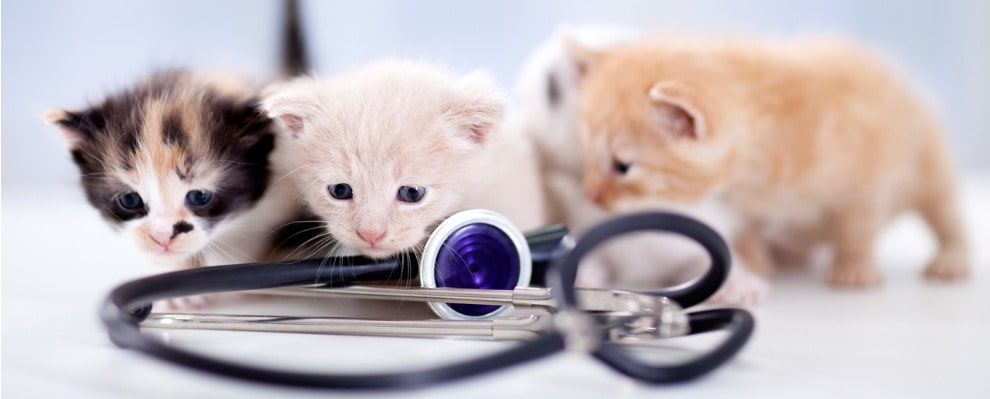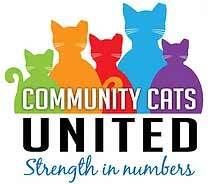Search Programs
When you click on a sponsoring school or program, or fill out a form to request information from a sponsoring school, we may earn a commission. View our advertising disclosure for more details.

Let’s face it: cats get a bad rap. Yes, sure, they can be antisocial. And they sometimes kill birds. And yes, they are often overlooked simply due to the overwhelming popularity of dogs.
But cats are also really cute. And furry. And make sweet sounds that sound even sweeter when spelled in French. To make a request en français, a cat says, miaou? To show it is content, “Ronron…nnn.” But apparently, cats just don’t have enough of a fan base, when compared to man’s best friend.
Case in point, about three million cats and three million dogs go into U.S. shelters each year, however, 71 percent of these cats are euthanized as opposed to 56 percent of dogs. This amounts to the euthanization of about 850,000 cats annually.
Fans of the cat, don’t despair. December is National Cat Lovers Month, and in honor of the event, we spoke with Beth Frank, president and founder of Community Cats United (CCU). It was due to the widespread neglect of the cat that Ms. Frank founded CCU, a nonprofit organization dedicated to the needs of community cats and their caregivers.
In the following interview, Ms. Frank sheds light on the oft-misunderstood community cat and what the public should know about the humane treatment of these overlooked animals. Melissa Flack, of The Animal Foundation, also contributed her expertise to this piece.
Meet the Experts: Beth Frank of Community Cats United and Melissa Flack of The Animal Foundation

Beth Frank is the founder and president of the board of directors for Community Cats United. The organization promotes the practice of Trap-Neuter-Return (TNR) as the humane solution to the overpopulation of community cats in neighborhoods.
“Our mission is to help community cats and their caretakers,” she shared. “Everything we do branches off of that.” Ms. Frank explained that CCU’s latest project is proactive animal sheltering, which is a focus on spaying and neutering to humanely reduce community cat intake in shelters.

Melissa Flack is the animal resource center manager at The Animal Foundation, the “highest volume, single-site shelter” in the U.S. Located in Las Vegas, Nevada, The Animal Foundation’s community cat program offers free trap rentals and free TNR surgeries. Their community outreach includes education on colony management and food donations to colony feeders who properly care for the cats in their neighborhood. This is all made possible from public donations.
The organization also provides free medical care for community cats if they are injured or sick. The public can reach out to the Animal Control agency in their jurisdiction or bring the cat in through their lost and found department. In 2020, The Animal Foundation met its “Mission Possible” goal of zero euthanizations of healthy, treatable animals under their care.
What are Community Cats?
Melissa Flack, the animal resource center manager for The Animal Foundation, defined community cats in an email:
Outdoor cats that are free-roaming or feral are considered community cats. These cats sometimes live in groups called colonies and choose their territories because they have a food source and shelter there. Community cats are beneficial because they keep additional cats from moving into the neighborhood as well as controlling rodent populations for their human neighbors.
However, the needs of such animals have been neglected. Unlike dogs who are dealt with according to the dog law of 1919, community cats are at the mercy of shelters and advocacy groups with differing philosophies. Ms. Frank explained,
The focus, many years ago, maybe 10 years ago or more was on spay and neuter, and somehow we’ve gotten away from that. Especially for cats…here in Michigan, a shelter [has] to take in dogs. Any dog that is presented to them, they have to take it in. Not so with cats. They can say, ‘We’re not taking cats.’ So what do people do with the cats? They dump them on the streets.
So some of the cats that are lumped in with the community population, Ms. Frank explained, may have different needs:
These cats are there basically because people abandoned them. They didn’t fix them. They multiply quickly. Cats multiply faster than dogs. We’ve looked to help dogs, and we’ve ignored our cats. So the problem is now at a really bad point about these cats. They don’t want to be there. We don’t want them to be there. We want all the cats to have a nice loving home, but even some of the big groups are saying, ‘Just put cats outside. They’re better off outside than in a sheltered environment’—but they don’t say to fix them.
Community Cat or Scapegoat?
There are several myths surrounding community cats. As mentioned earlier, cats get a bad wrap for their predatory behavior towards birds. Ms. Frank pointed out a contradiction in holding this natural instinct against felines.
“Cats will kill birds but, that’s the cycle of life,” she said. “We eat animals; animals eat other animals. It’s not just cats eating birds.”
She continued,
There’s a lot of other issues killing birds—pesticides, windmills for power, skyscrapers…in New York the other day, they had hundreds of migratory birds run into skyscrapers and get killed. Cats didn’t have anything to do with that. And you know the biggest group that hurts birds? It’s humans. They shoot them, they have hunting seasons for them…they put pesticides out. They build big buildings. It’s not the cat’s fault.
Furthermore, Ms. Frank argued that if community cats are properly cared for, the killing of birds becomes a non-issue: “If cats are maintained in a colony, they don’t really kill to eat,” she explained. “The amount of killing really goes down…in a managed colony where they’re fixed and they’re fed. They don’t have so much inclination to kill birds then.”
The Animal Foundation’s Ms. Flack pointed out another commonly held belief that a community cat equals a feral cat. However, “not all community cats demonstrate feral tendencies,” she said. “This means community cats can be friendly to feral or anywhere in between.”
Ms. Frank explained further that “if it’s a true feral cat, that cat is not going to come up to you. So if the cat is coming up to you, it’s had some kind of human interaction along the way, and it might be partially feral and partially friendly.”
Another misconception about community cats is that they need a home. Ms. Flack strongly advocated against this notion:
Community cats don’t need to be rehomed because they already have a home! These cats are happy living in their colonies and neighborhoods. Trapping community cats and moving them to a new neighborhood will not solve the problem. New cats will move into the territory. Your best option is to trap, neuter, and return the community cats that live in your neighborhood. They will continue to protect their territory and prevent new cats from moving in.
Ms. Frank emphasized that folks should be sure that they’re returning a cat that can truly fend for itself—not one that’s been abandoned: “A house cat doesn’t have the same instincts that a cat living outside has had.”
A final myth that is often associated with community cats is that they carry disease. Ms. Flack countered this misinformation by asserting that “community cats are not a health risk to humans. Cats are not natural carriers for rabies, although we vaccinate against rabies as part of our TNR project.”
Trap-Neuter-Return (TNR)
Community Cats United advocates for trap-neuter-return (TNR) as the only humane solution to the overpopulation of community cats. The Animal Foundation concurs. “These cats should only be brought to The Animal Foundation to utilize our TNR program or receive medical care.” Ms. Flack continued,
The main focus of the community cats program at The Animal Foundation is to save lives. Once TNR is in place, cats will no longer reproduce. As long as the colony continues to be managed appropriately, the population will decline naturally. Female cats can reproduce up to four times a year. TNR relieves cats of the physical and mental demands and consequences of mating, pregnancy, and fending for their young.
However, Ms. Frank shared that not everyone in the community cat movement agrees on the efficacy of the practice: “People argue that TNR hasn’t made any difference, but the problem is funding. Most people are volunteers paying out of their pocket for this,” she said.
Relocation is another option; however, transport is only a temporary solution and one that is more often used with regard to dogs. This is especially true in the case of Pitbulls, which are abundant in shelters.
For decades, community cats were dealt with by the “trap and kill” method. Ms. Frank argues that, regardless of the humanity of the practice, it has not been effective: “We have more cats than ever,” she said.
Big groups are working towards going to no-kill by 2021, “but this is an incomplete approach because the cats are often returned to fend for themselves,” Ms. Frank stated. “But they may be declawed; they may not be fixed…it’s not the same goal.”
Even within the advocates for TNR, there are two kinds of schools: those who return and those who try to adopt the cats out, especially in the case of kittens. With adult cats who are friendly, they may try to find them homes either initially, right after trapping and neutering, or at a later date, after returning the cat to the colony for a period of time. In this case, rescue groups will do the adoption.
“The most important thing is to get them fixed to stop the reproduction,” Ms. Frank said, explaining that “true” TNR people will return.
We feel that whatever helps the cats. We want to get them spayed and neutered. And if you want to get them fixed and return them, that’s fine. If you want to get them fixed, adopt out the friendlies and return the other ones. That’s fine, too, because the bottom line is we need to get the cats fixed.
How to Advocate for Community Cats
Are you a cat lover that wants to advocate for community cats? You’re needed!
“The public is made up of a lot of dog people. We don’t pay as much attention to [cats],” Ms. Frank said. The following is a list of actions she offered for those interested in supporting the Community Cat Movement:
- Understand – The no-kill movement is an incomplete approach.
- Educate – Explain TNR so that others understand the practice and its benefits.
- Share research on shelter data – It costs about $500 to shelter a cat, much higher than the cost to spay/neuter.
- Support vets – These professionals have an alarmingly high rate of suicide and have been under increased stress due to the pandemic.
- Volunteer

